IEAA Events - Fall 2024
Nineteenth Annual William J. Murnane Memorial Lecture
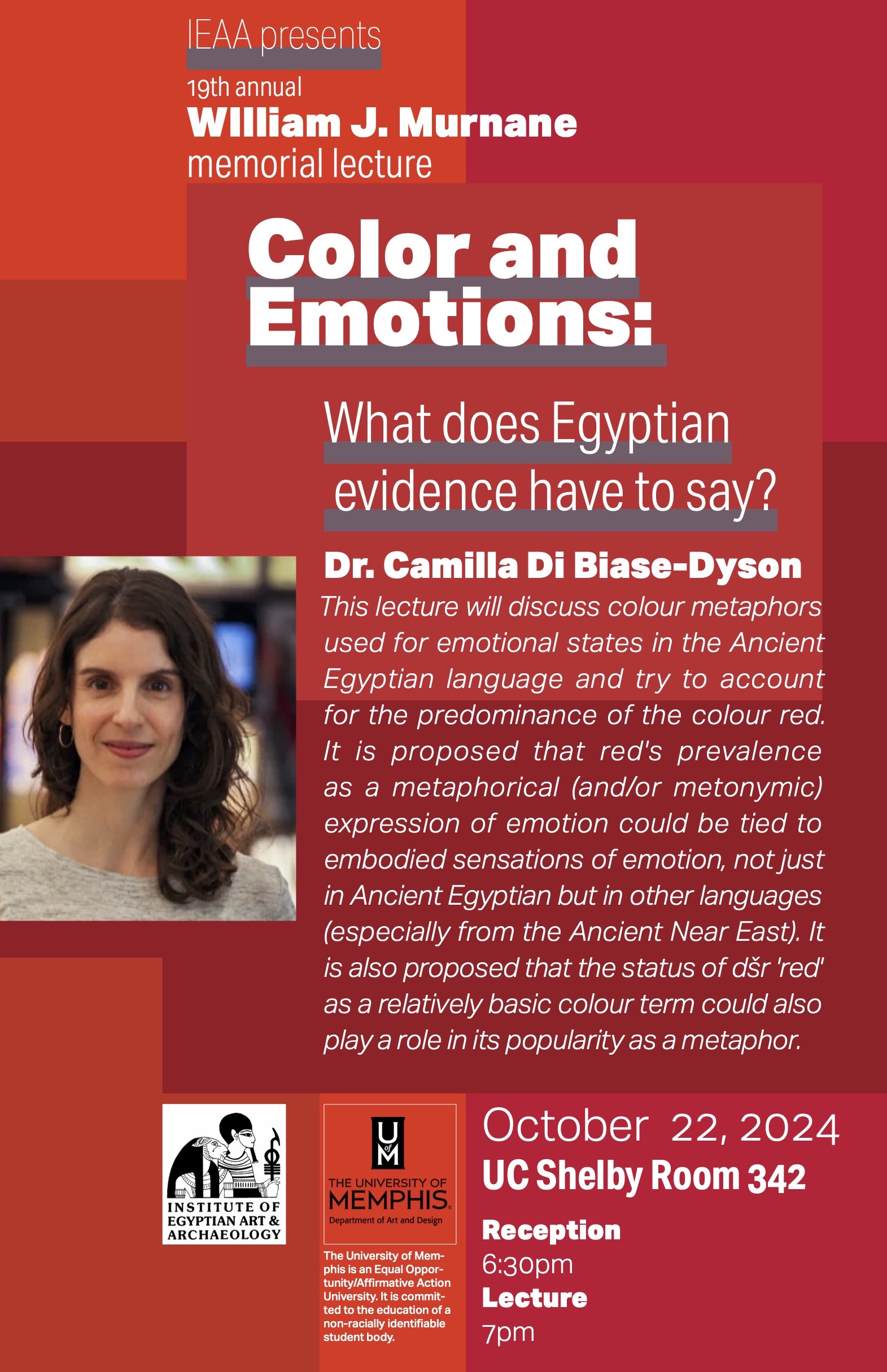 By: Dr. Camilla Di Biase-Dyson
By: Dr. Camilla Di Biase-Dyson
Senior Lecturer, Department of History and Archaeology
Macquarie University
Location: University Center, Shelby Room 342 University of Memphis Campus
Paid parking is available in the Zach Curlin Garage adjacent to the UC.
Dr. Biase-Dyson received her BA and PhD in Ancient History from Macquarie University, and conducted postdoctoral research in Egyptology and linguistics. She has held the positions of Junior Professor for Egyptology at the Georg-August University in Göttingen and Research Fellow at the University of Vienna. Since 2020, Dr. Biase-Dyson has been Lecturer in Egyptology at Macquarie University.
Dr. Biase-Dyson's research explores how ancient texts and languages help us access ancient ways of thinking. Her current research focuses on word meaning in the Ancient Egyptian language, manuscript studies and object studies, and ancient medicine and body ontologies. Her approaches range from linguistics and cognitive science to literary analysis and anthropology. She utilizes the tools of digital corpus analysis for ancient languages, taking case studies from texts and materials of the Ramesside Period of Egyptian history, in the Late Bronze Age.
Eighth Annual Alumnae/Alumni Lecture Series
 By: Dr. Robyn Price
By: Dr. Robyn Price
Post-doctoral Research Associate
Joukowsky Institute for Archaeology and the Ancient World
Brown University
Location: University Center, Fountain View Rm 350 University of Memphis Campus
Paid parking is available in the Zach Curlin Garage adjacent to the UC.
Dr. Price received her MA in linguistic anthropology at the University of Virginia, her MA in art history with a concentration in Egyptian art and archaeology at the University of Memphis, and her PhD in archaeology at the Cotsen Institute, University of California, Los Angeles.
Dr. Price’s research involves the role of scent in ancient Egyptian mummification practices and in the social and economic power dynamics of New Kingdom Egypt (1550-1050 BCE). The application of aromatic materials like incense, perfumes, and flowers, applied to the deceased’s body as a step in the mummification process did not simply disguise the aroma of death. Rather, the overlaying of malodors with pleasing scents was an integral part of the process of reinvigorating the deceased’s being. Through mummification and the ritual application of pleasantly fragrant scents, the deceased’s body was transformed, both symbolically and physically. Restricted access to expensive, non-native scents, however, limited who might be accorded this funerary privilege thereby codifying a social hierarchy through scent. Death rituals are rarely only for the deceased, however. They function as a performance for the living. Thus, scent, an integral aspect of ancient Egyptian funerary practices, was also the means by which the living could display their status. This presentation delves into the interplay between scent and ancient Egyptian funerary practices, emphasizing the profound significance of fragrance in denying death and in manipulating the living.
Please note that this presentation may include images of material culture such as sarcophagi or resin soaked bandages associated with ancient Egyptian burials. It will not include photographs of the deceased persons themselves.
Double Lecture by Visiting Egyptologists
“Recent Research on Ancient Egyptian Funerary Masks and Animal Mummies”
By Dr. Carlo Rindi Nuzzolo and Dr. Maria Diletta Pubblico
Wednesday, September 4th, 2024
Reception: 6:15pm; Lecture at 7pm
UC Shelby Room 342
University of Memphis Campus
Dr. Carlo Rindi Nuzzolo, a Marie Skłodowska-Curie Postdoctoral Global Fellow currently attached to the Cotsen Institute of Archaeology at UCLA and the Institute for Heritage Science (XRayLab, ISPC-CNR, Catania, Italy), will discuss his research on the manufacture of cartonnage mummy masks from Ptolemaic and Roman era Egyptian sites as part of his project CRAFT (Cartonnage Regionalism in the Ateliers of the Fayum Territory).
Dr. Maria Diletto Pubblico, a Marie Skłodowska-Curie Actions Postdoctoral Global Fellow at the Museo Egizio in Turin and the UCLA Cotsen Institute of Archaeology, will share her research on animal mummy wrappings as part of her project, SEAMS (A Study of Egyptian Animal Mummies Styles).
Both scholars will be studying antiquities in the IEAA collection to add to their database of objects. The lectures will focus on the use of modern technologies to acquire information about their manufacture that helps to answer questions about the dates and production sites of these unique types of objects.
IEAA Events - Spring 2024
- IEAA Family Day - Saturday, April 13, 2024 from 12:00pm - 4:00 pm.
-
Twentieth Annual Legacy of Egypt Lecture, Dr. Luigi Prada, "Resurrecting the Words of the Gods: Neo-hieroglyphic Inscriptions in 19th Century Egyptomania" - Tuesday, April 23, 2024 at 7:00pm CDT
Twentieth Annual Legacy of Egypt Lecture

"Resurrecting the Words of the Gods: Neo-hieroglyphic Inscriptions in 19th Century
Egyptomania"
Dr. Luigi Prada
Date: Tuesday, April 23, 2024
Time: 7:00pm (reception at 6:15)
Location: University Center
Shelby Room 342
University of Memphis
Dr. Luigi Prada is Assistant Professor of Egyptology at Uppsala University, Sweden. He was educated in both Egyptology and Classics, firstly in Italy and then in England, receiving his DPhil in Egyptology at the University of Oxford. He works primarily on textual and cultural-historical studies, with a particular focus on the later phases of Egypt's history and language(s)/scripts. Prior to Uppsala, he held academic positions in the UK (Oxford), Germany (Heidelberg), and Denmark (Copenhagen). He is active in the field, both in Egypt as Assistant Director of the Oxford-Uppsala Epigraphic Project in Elkab, and in the Sudan.
This lecture will explore the cultural aftermath of Champollion’s decipherment of hieroglyphs in 1822, a linguistic breakthrough with wide social, political, and art historical influence. Throughout the European continent, royalty, and even popes, commissioned novel hieroglyphic inscriptions on monuments celebrating their power building upon the Egyptomania which had already gripped the world at the turn of the previous century as a result of Napoleon’s Egyptian expedition. This lecture will present this peculiar, half-scholarly half-populist, phenomenon, discuss a number of case studies through analysis of the original monuments, and contextualise them within the development of early Egyptology as a form of Europe’s colonial appropriation of Egypt.
IEAA Family Day

Date: Saturday, April 13, 2024
Time: 12:00pm-4:00pm
Location: Art Museum of the University of Memphis
142 Communication and Fine Arts Building
3750 Norriswood Ave.
Join us for an afternoon of Egypt-themed fun, including tours of the Egyptian exhibition and activities including making your own Egyptian amulets, learning to write your name in hieroglyphs, and much more! Free and open to the public. For more information, email ldhckley@memphis.edu or call 901-678-2649.
IEAA Events - Fall 2023
-
The Eighteenth Annual William J. Murnane Memorial Lecture, Dr. Jaquelyn Williamson, "Nefertiti and Her Sun Temple at Tell el Amarna" - Thursday, October 26th, 2023 at 7:00 p.m.
-
Seventh Annual IEAA Almuni/Alumnae Lecture, Dr. Michelle Marlar, "The Osiris Temple at Abydos: Phases and Destruction" - Thursday, September 21st, 2023 at 7:00 p.m.
IEAA Events - Spring 2023
-
Nineteenth Annual Legacy of Egypt Lecture, Dr. Peter Der Manuelian, "Walking Among Pharaohs: George A. Reisner, Harvard's First Egyptologist" - Thursday, April 6, 2023 at 6:00pm CDT (eEvent)
-
Special Lecture, Dr. Amr Khalaf Shahat, "Social History of Food in Ancient Egypt" - Monday, March 20, 2023 at 6:30 p.m.
Co-Sponsored by the Tennessee Chapter of the American Research Center in Egypt
IEAA Events - Fall 2022
-
Seventeenth Annual William J. Murnane Memorial Lecture, Dr. Marc Gabolde - Thursday, December 15, 2022 at 6:00 p.m. CST (eEvent)
-
Special Tutankhamun Lecture, Dr. Peter J. Brand, "Tutankhamun’s Golden Journey to the Afterlife" - Friday, November 4, 2022
Co-Sponsored by the Egyptology Graduate Student Assocation and the Tennessee Chapter of the American Research Center in Egypt
-
Sixth Annual IEAA Alumnae/Alumni Lecture, Dr. Mark Janzen - Thursday, October 27, 2022 at 7:00 PM
-
Special Lecture, Dr. Lorelei H. Corcoran, “Wonderful Things’: Decoding Tutankhamun’s Jewelry” - Thursday, October 20, 2022
Co-Sponsored by the Egyptology Graduate Student Assocation and the Tennessee Chapter of the American Research Center in Egypt
-
IEAA Ancient Egypt Family Day on the Internet - Open through September 30, 2022 (this resource is no longer available)
Events for Fall 2023
Eighteenth Annual William J. Murnane Memorial Lecture
"Nefertiti and Her Sun Temple at Tell el Amarna"
A Public Lecture by Dr. Jaquelyn Williamson
Date: Thursday, October 26th, 2023
Time: 7:00 p.m. CST
Location: University Center, Fountain View Suite, Room 350
Jacquelyn Williamson earned her BA at Sarah Lawrence and her MA and PhD at Johns Hopkins University. She has been a curatorial research associate at the Harvard Museum of the Ancient Near East and a visiting professor and research associate at Brandeis University, the Harvard Divinity School, and the University of California, Berkeley. Since 2005, she has been a member of the Tell el-Amarna Expedition as project director at Kom el-Nana.
Nefertiti, the queen whose name literally means, “the beautiful one has arrived” is an icon of beauty in Ancient Egyptian art but she also played an important role in the religious and political changes initiated in the mid-Eighteenth Dynasty. In this talk, Dr. Jacquelyn Williamson will discuss her discovery of the “Sunshade of Re,” a temple belonging to Nefertiti at the site of Kom el Nana, at Tell el-Amarna, the capital city built by her husband, King Akhenaten (ca. 1350 BCE) and the birthplace of king Tutankhamun. Williamson will review architectural, textual, and artistic evidence to demonstrate how this enigmatic temple may have functioned during Nefertiti's lifetime.
Seventh Annual IEAA Almuni/Alumnae Lecture
"The Osiris Temple at Abydos: Phases and Destruction"
A Public Lecture by Dr. Michelle Marlar
Date: Thursday, September 21st, 2023
Time: 7:00 p.m. CST
Location: Art & Communication Building (ACB) Rm 310, University of Memphis Campus
Michelle Marlar received her MA in art history with a concentration in Egyptian art and archaeology at the University of Memphis and her PhD in ancient Egyptian archaeology and art history from the Institute of Fine Arts, New York University. She has been a field director at Abydos as part of the Penn, Yale, NYU Expedition and currently works as the co-director of a joint American-Egyptian mission at the Hathor Temple in ancient Memphis, Egypt, in her role as director of the Egyptian Archeological Missions at the Houston Museum of Natural Science.
Dr. Marlar will highlight the results of two decades of research by a consortium of universities (Penn, Yale, and NYU) at the site of Abydos, considered to be the burial place of the god of the dead, Osiris. The site became his cult center and was a pilgrimage destination until Late Antiquity. The lecture will cover the excavation, conservation, and documentation of the rich history of the Temple of Osiris and address the architecture, artifacts, and decorative programs for each phase of the life of the temple.
Events for Spring 2023
Some of the events below will take place online. All programs are free, but online
registration may be required.
Nineteenth Annual Legacy of Egypt Lecture (eEvent)
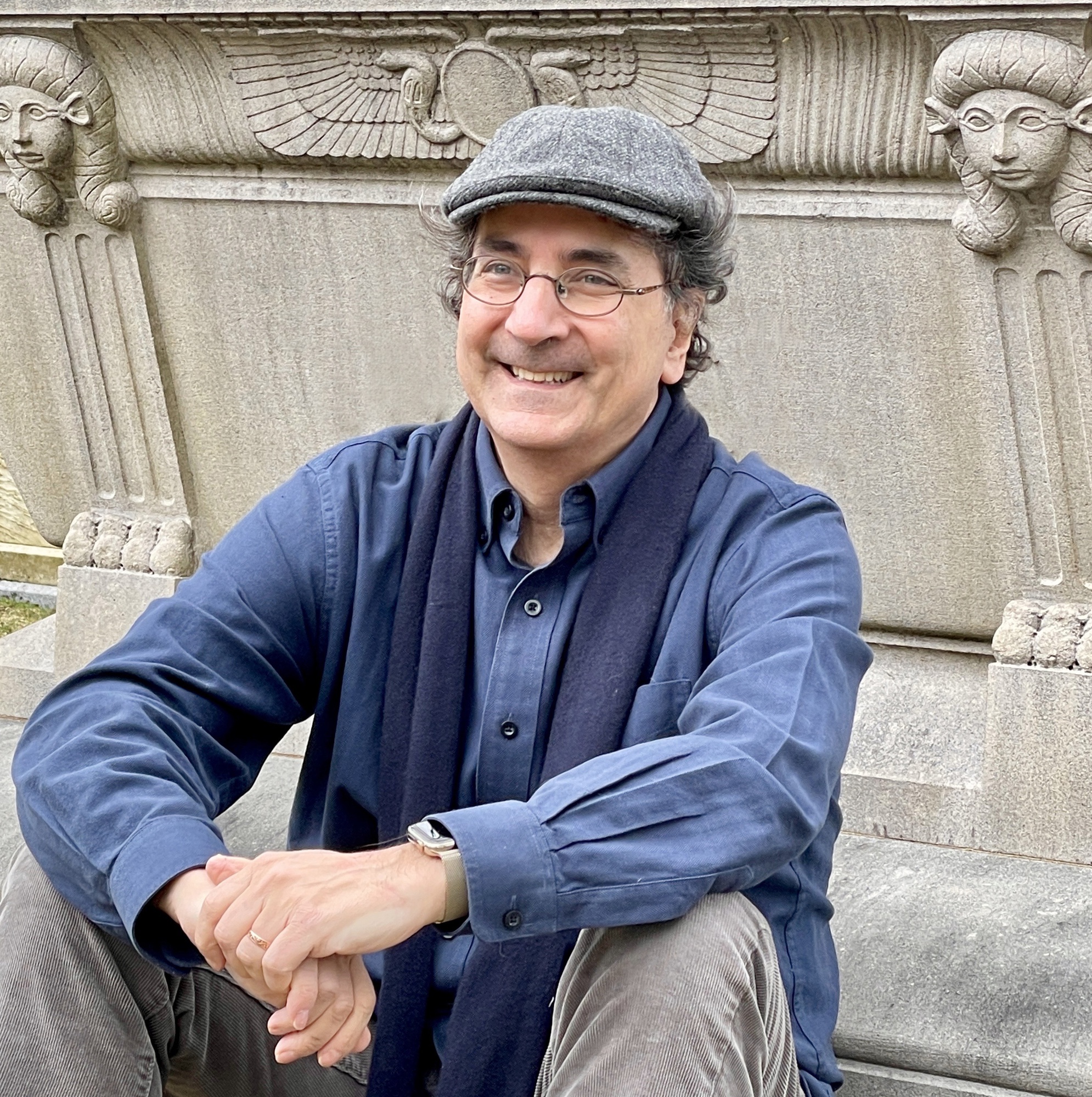 "Walking Among Pharaohs: George A. Reisner, Harvard's First Egyptologist."
"Walking Among Pharaohs: George A. Reisner, Harvard's First Egyptologist."
A Public Lecture by Dr. Peter Der Manuelian
Date: Thursday, April 6, 2023
Time: 6:00 p.m. CDT
Location: Online - https://youtu.be/HWXtnDAy6CY
This lecture will remain on Youtube after its premiere.
Dr. Peter Der Manuelian is the Barbara Bell Professor of Egyptology in both the Department
of Near Eastern Languages and Civilizations and Anthropology at Harvard University
and Director of the Harvard Museum of the Ancient Near East. He is also the founding
director of the Giza Archives Project, an indispensable research tool for the study
of the Old Kingdom, which collects and presents online public access to all past and
present records of archaeological activity at the Giza Pyramids plateau.
This lecture offers an introduction to Dr. Peter Der Manuelian's research and teaching interests that include a visualization and digital humanities approach to understanding the ancient world and to his most recent publication, Walking Among Pharaohs, George A. Reisner and the Dawn of Modern Egyptology (Oxford, 2022), a biography that draws upon the field notes, letters, maps and images of George Reisner, one of the giants in the early twentieth century archaeology of Egypt and Sudan. Reisner's finds while director of the Harvard University - Boston Museum of Fine Arts Expeditions made the Egyptian and Nubian collections of the Museum of Fine Arts, Boston, one of the most spectacular outside Egypt, although his personal views and published conclusions are a part of the colonialist past of the study of ancient Egypt that today faces increasing scrutiny. Please explore with us the past, present and future of the field of Egyptology and digital archaeology with this lecture by Dr. Peter Der Manuelian.
Click here for the link to the poster.
This online event is free and open to the public.
Special Food Lecture
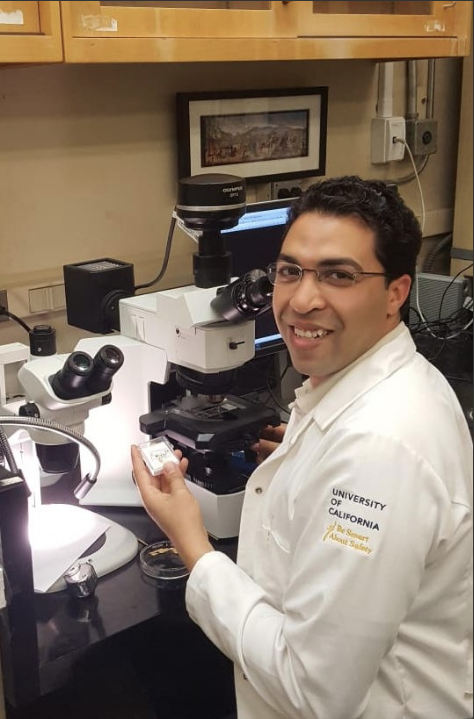 "Social History of Food in Ancient Egypt Between Humanities and Life Sciences."
"Social History of Food in Ancient Egypt Between Humanities and Life Sciences."
A Public Lecture by Dr. Amr Khalaf Shahat
Date: March 20, 2023
Time: 6:30 p.m. CST
Location: Mitchell Hall Auditorium (Room 200) and live on Zoom
Dr. Amr Khalaf Shahat is a postdoctoral researcher at Costen Institute of Archaeology,
University of California, Los Angeles. His research focuses on ancient Egyptian food
remains that were placed as offerings in tombs and from settlements to understand
cultural identities and cross-cultural interactions. He earned his doctorate at University
of California Los Angeles and his Masters in the History Department at the University
of Memphis.
The results of an interdisciplinary analysis using archaeobotany and isotopic methods on unpublished ancient Egyptian food remains from Nag ed Deir and Deir el Ballas will be presented. The food remains were excavated in the early 1900s by George Reisner and Albert Lythgoe. At Nag ed Deir, a beer mash was examined and Dr. Shahat was able to reconstruct the beer composition and recipe. He also employed a long isotope experiment to differentiate between local and imported plant food species which found the oldest known evidence for the use of pomogranate and domesticated watermelon in Egypt. The results of these two analyses allowed the social history of non-elite ancient Egyptian foodways to be reconstructed and the examination of cultural identities and cross-cultural interactions.
To join the Zoom Meeting, copy the link below at the time at the lecture:
https://us02web.zoom.us/j/83603140777?pwd=OFpvc2FpMXFTDF0VnBITWtUdGNXdz09
Click here for the link to the poster.
For those attending in-person, pay parking ($3.00 per hour) is available in the adjacent Zach Curlin garage.
Events for Fall 2022
Seventeenth Annual William J. Murnane Memorial Lecture
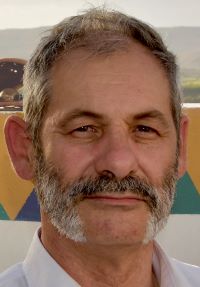 "Ay's Temple for Tutankhamun at Thebes."
"Ay's Temple for Tutankhamun at Thebes."
A Virtual Public Lecture by Dr. Marc Gabolde
Date: December 15, 2022
Time: 6:00 p.m. CST
Location: Online - https://www.youtube.com/watch?v=Z5QlY5SPbts
This lecture will remain on YouTube after its premiere.
Dr. Marc Gabolde is Professor of Egyptology at Paul-Valéry University – Montpellier III, Montpellier,
France. He is a member of the Nilotic and Mediterranean Egypt team in the Archeology
of Mediterranean societies unit. He currently is working on completing a Study of
the Temples of Karnak and publication of the Tutankhamun memorial built by Ay.
Dr. Gabolde will present a chronological survey of the study of the decorated blocks recovered mainly from the Second Pylon at Karnak Temple in Luxor that formed the basis of his decades-long study and propose his reconstruction of a temple (funerary or memorial?) at Thebes (East or West?) built by King Ay to honor his predecessor, Tutankhamun.
Professor Gabolde, a renowned expert on the Amarna period, is a former scientific member of the French Archaeological Institute in Cairo, a former member and director of the excavations of the Royal Valley at the site of Amarna. He has conducted missions at Karnak, the Valley of the Queens, Tell el-Amarna, Balat and Tebtunis. His current research focus is on the late 18th dynasty and is the author of over one hundred contributions to the study of Egyptology, both in English and French.
This online event is free and open to the public.
Special Tutankhamun Lecture

"Tutankhamun’s Golden Journey to the Afterlife"
A Public Lecture by Dr. Peter J. Brand
Date: Friday, November 4, 2022
Lecture: 7:00 PM CST
Public Reception: 6:30 PM CST
Location: Fountain View Suite (University Center Room 350) and live on Zoom
On the centenary of the discovery of his tomb on November 4th, 1922, we will explore Tutankhamun’s journey into the afterlife through his spectacular burial treasures: golden coffins, gold death mask, jewelry, and other sacred objects placed on and around his mummy to ensure his body’s preservation and his spirit’s rebirth in the Egyptian Underworld. This golden horde of priceless artifacts represent the summit of Egyptian artistry and offer unique insight into how this ancient civilization prepared their kings for the journey to the beyond.
Peter J. Brand (Ph.D., University of Toronto) is an Egyptologist specializing in history, art, language, and epigraphy. His research examines the history and culture of New Kingdom Egypt (ca. 1550-1100 BCE), especially the Ramesside Period. He has authored four books and dozens of articles on Egyptian kingship, monumental construction, popular religion, warfare, and diplomacy. Professor Brand teaches in the History Department at The University of Memphis (TN) and is the Director of the Karnak Great Hypostyle Hall Project, a joint endeavor of The University of Memphis and the Université de Québec à Montréal. The Project is recording, conserving, and interpreting hundreds of scenes and hieroglyphic texts carved on the Hall’s walls and its forest of 134 giant columns. Professor Brand often appears in documentaries for the History Channel, Discovery, and National Geographic. His forthcoming book Ramesses II: Egypt’s Ultimate Pharaoh, is a new biography of this celebrated pharaoh.
To join the Zoom Meeting, copy the link below at the time at the lecture:
https://us02web.zoom.us/j/83049421063?pwd=YXl2WXc2NkhmSVN2NVFCN1ZFdGh5QT09
Meeting ID: 830 4942 1063
Passcode: 341311
Click here for the link to the poster.
For more information, contact Daniel Warne (dmwarne@memphis.edu).
For those attending in-person, pay parking ($3.00 per hour) is available in the adjacent
Zach Curlin garage.
Sixth Annual IEAA Alumnae/Alumni Lecture

"Merenptah or Ramesses II: Who Commissioned the Battle Reliefs at Karnak Temple?"
A Public Lecture by Dr. Mark Janzen
Date: Thursday, October 27, 2022
Lecture: 7:00 PM CST
Reception: 6:15 PM CST
Location: Fountain View Suite (University Center Room 350)
Mark Janzen, PhD, is an Associate Professor of Archaeology and Ancient History at Lipscomb University in Nashville, TN. He will present the results of his team’s recent fieldwork at Karnak Temple in Luxor, Egypt. Dr. Janzen earned his doctorate in the Department of History at the University of Memphis in 2013.
Following Ramesses II’s sixty-seven-year rule, his son, Merenptah, succeeded Ramesses to the throne. Ramesses had already decorated most of the walls of the great temple of Amun at Karnak leaving only a few potential locations for his son to embellish. On a corner wall, next to where the first peace treaty in history is carved, celebrating the self-claimed victory of Ramesses II over the Hittites at the Battle of Qadesh, is a series of scenes of battles at fortified towns. During four seasons of epigraphic fieldwork, conducted under the auspices of the Great Hypostyle Hall Project of the University of Memphis and under the supervision of Dr. Janzen, scientific examination and reproduction of these scenes has revealed that although the name of Ramesses II survives in a text at the top of the wall, Merenptah was responsible for these battle reliefs. This lecture will expand on the project’s research since 2016 and discuss its future goals.
Dr. Janzen received his PhD in History, with a concentration in Ancient History (Egyptology), at the University of Memphis in 2013. His dissertation focused on the depiction and treatment of foreign captives as represented in the New Kingdom. Dr. Janzen has lectured and published on his work using photogrammetry and sociospatial analyses to interpret Egyptian history.
For more information, contact Dr. Lorelei H. Corcoran (lcorcorn@memphis.edu) or call the IEAA at 901.678.2555.
Pay parking ($3.00 per hour) is available in the adjacent Zach Curlin garage.
Ancient Egypt Family Day on the Internet
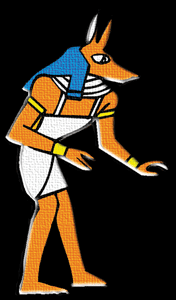 Coming to a computer near you!
Coming to a computer near you!
Join us for a fun and FREE online public event with lots of fun and interesting activities
for all!
Content will be available from April 18 through September 30, 2022. (This resource is no longer available.)
This year we also have links to resources for educators and parents.
